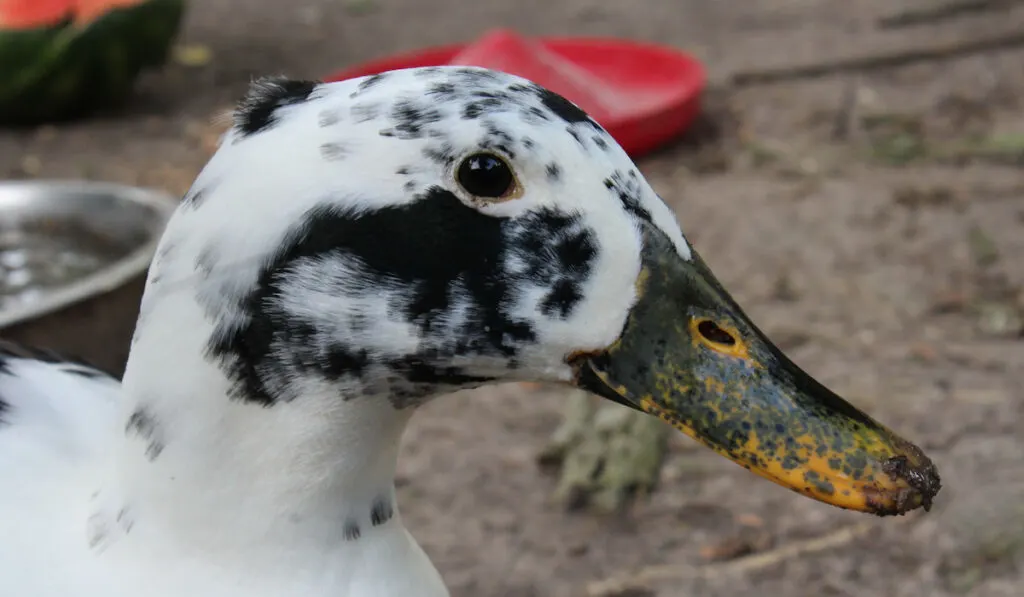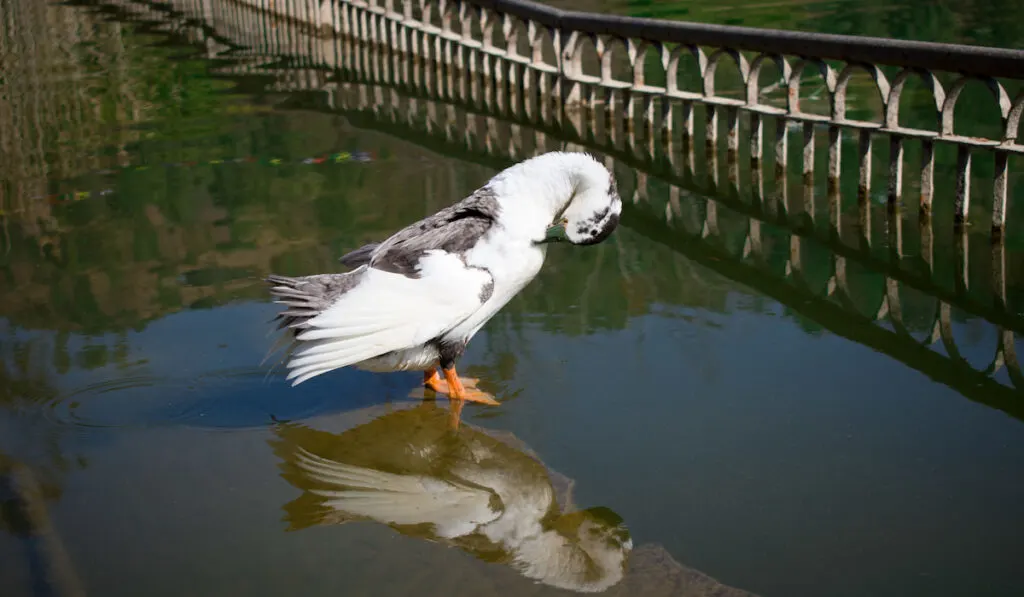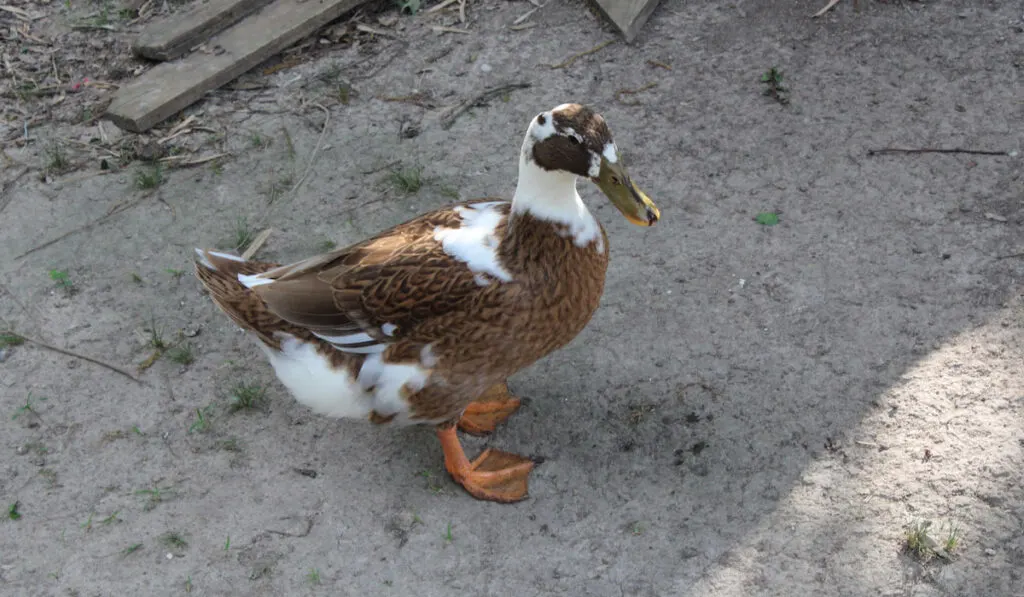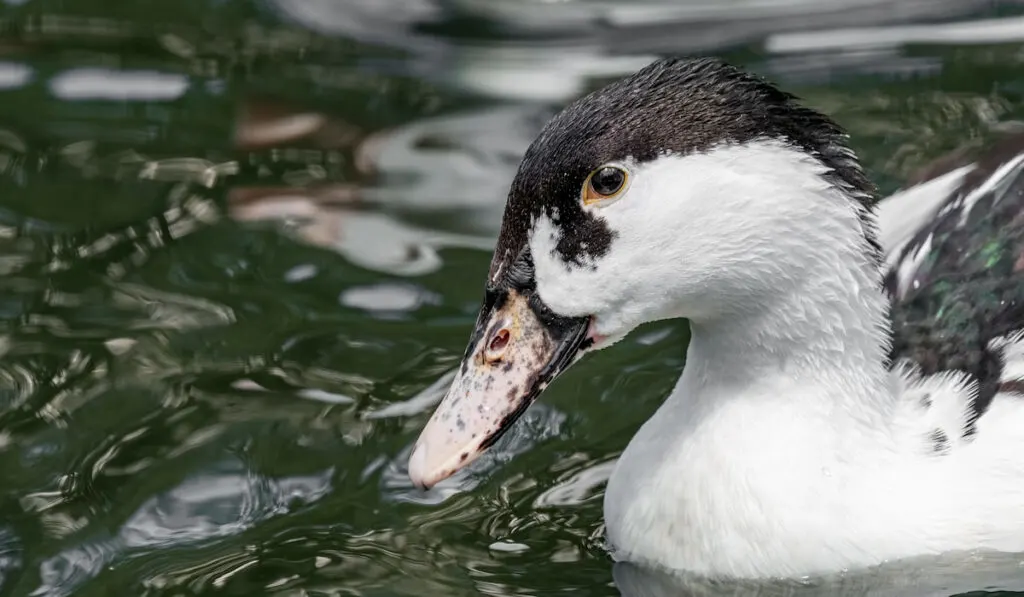Are you looking for a friendly, sociable, and trainable duck? Look no further than the Ancona breed.
Ancona ducks are among the rarest domesticated duck breeds. A unique and diverse broken-color plumage pattern distinguishes the Ancona duck breed. This bird is famous for its resilience, productivity, and distinctive beauty.
This article takes a deeper look into the Ancona duck breed profile. Please keep reading to learn the breed’s origin, characteristics, uses, and more!

Table of Contents
History and Origin
The origin of the Ancona duck is inconclusive.
For many years, people thought the breed originated in Great Britain, but new research suggests that it originated in America.
This suggestion follows intensive searches in the United States and Great Britain.
Breeders crossed several breeds to create the Ancona duck. They included:
- The Indian Runner duck
- The Belgian Huttegem duck
They came up with a sturdy and highly productive breed.
The Ancona duck first became known in the US in the mid-20th century. Their popularity increased rapidly due to their superior egg-laying prowess and lovely plumage.
However, the breed experienced a population decline in the late 20th century. Presently, the Ancona duck is on the Livestock Conservancy’s list as endangered.
Is This an APA-Recognized Breed?
The American Poultry Association (APA) has yet to recognize or list the Ancona duck breed.

Breed Standard
Here are the standard physical traits of the Ancona duck as suggested by an American breeder:
Body
The Ancona duck has a broad, deep chest. It also features a slightly elevated, rounded rump and a straight, firm back.
Head and Neck
The bird has a tiny, rounded head with a concave profile. Its bill is robust, of medium length, and has an upturned tip. The neck is high and slightly arched.
Eyes
The duck’s eyes are large and spaced widely apart on the head. They are bright and attentive.
Plumage
The Ancona duck has a distinctive pattern of erratic, well-defined dots in its black and white mottled plumage.
The entire body is predominantly white with black spots.
Rare Colors
The rare color variations for the Ancona ducks include pure white, solid black, blue, and silver.
Wings
The bird’s wings are well-built and sturdy.
Feet and Legs
The legs and feet are sturdy, well-spaced, and of medium length. They are yellow or orange in hue.
Size/Height/Weight
The Ancona are medium-sized ducks. Adult females weigh between 6 and 7 pounds (2.7–3.1 kg), whereas males weigh 6–8 pounds (2.7–3.6 kg).

Temperament
The Ancona ducks are naturally gentle and submissive. They are calmer, friendly, and less aggressive than other duck breeds.
These birds are energetic and curious. And they are an ideal choice if you want a friendly and trainable duck.
The Ancona ducks are well-behaved. However, like all animals, their behavior depends on their surroundings and upbringing.
Early training and socialization can help them grow into pleasant and well-behaved birds.
Breed Purposes/Uses
You can raise Ancona ducks for various purposes. They include:
Egg Production
The primary purpose of Ancona ducks is egg production.
You can use the eggs in commercial and culinary applications.
The Ancona is a very productive breed; they can lay 210–280 eggs annually. The eggs weigh 2.5 to 3 oz. (70–85 g) and are white or cream.
Meat Production
Some breeders raise Ancona ducks for their meat. They have leaner, more nutritious meat compared to Pekin ducks.
Pest Control
Due to their excellent foraging abilities, Ancona ducks can help manage pests in your garden. They consume insects, slugs, and snails that can harm plants and crops.
Raising them is an excellent organic and cost-effective pest management method.
Exhibition and Show
Due to their aesthetic appeal and showmanship, you can keep Ancona ducks as exhibition birds. Their distinctive black and white markings make them outstanding at displays and exhibits.
Pets
The Ancona ducks make excellent pets if you have space and time to care for them. They are friendly and pleasant; you can even train them to follow you.
The ducks also coexist well with other domestic animals like goats and hens.

Hatching/Raising
Ancona ducks make terrific mothers and will instinctively care for their young.
Here are their hatching/raising traits.
Hatching
The Ancona ducks seldom go broody but are good at caring for their ducklings. Therefore, consider using an incubator for hatching the eggs.
The incubation period for Ancona duck eggs is 28 to 35 days.
Raising
The mother duck will look after her ducklings by keeping them warm. She will shield them from predators and teach them how to forage and swim.
The ducklings need a lot of room to move around and access suitable food and water.
Feeding
Ancona ducks need a well-balanced diet for proper growth and development. They require a diet low in carbs and high in protein.
Give them a mixture of canned duck food and fresh greens and vegetables. Also, remember to offer them grit to help enhance their digestive system.
Shelter
Providing your birds with safe and secure housing is crucial. Ensure the shelter is warm and dry, predator-proof, with enough bedding and proper ventilation.

Cold and Heat Tolerance
The Ancona ducks are resilient and adaptable to diverse conditions.
Cold Tolerance
Ancona ducks can thrive well in cold weather. They manage their body temperature by:
- Fluffing up their feathers
- Tucking their bills into their feathers to prevent heat loss.
They also have a thick coating of down feathers that insulates them against the cold.
Heat Tolerance
Although the Ancona ducks are hardy birds, they could suffer heat stress if exposed to scorching and humid weather. Heat stress affects their health and egg production.
You can help keep them cool by providing shade and cool drinking water. Also, ensure they can access a pool to swim or splash.
Sexing (How to Tell Males From Females)
There are three easy ways to tell a male from a female Ancona duck. They include:
- Sound: females have a much clearer and louder quack, while males have a rusty quack.
- Tail: male ducks have up-curled tail feathers, while females have straight tail feathers.
- Size: the male birds are more sizeable and have a broader frame than females.

Pros and Cons
Pros
Egg Production
Ancona ducks are prolific egg producers; some lay up to 300 eggs annually.
These eggs are ideal for baking because they are big and have a higher yolk-to-white ratio.
Meat Production
You can also raise the Ancona ducks for their meat. Their flesh is delicious and lean, making it a favorite among chefs and culinary enthusiasts.
Pest Control
These birds consume insects, slugs, and snails that are harmful to crops. They are thus cost-effective natural pest controllers, eliminating the use of chemicals.
Easy of Care
The Ancona ducks are calm, amiable, and easy to raise. Thus, they are ideal if you are new to duck raising or have young children.
Cons
Noise
Like all ducks, these birds can be noisy, particularly during their mating season. This noise can be an issue if you live in an urban setting.
Messy
The Ancona ducks do not differ from other breeds in having filthy habits. Since they generate a lot of garbage, managing them can be challenging.
Predators
Ducks are susceptible to predators such as foxes, raccoons, and raptors. You risk losing your birds if you don’t adequately fence or protect them.
Health Issues
The Ancona ducks are prone to various medical conditions. The most common ones are:
- Parasite infestation
- Respiratory infections
- Nutritional imbalances
If you do not know about duck health, it would be helpful to schedule routine veterinary checks.
Water Requirement
Ancona ducks need access to plenty of water. Besides drinking, these birds love swimming or splashing around.
Also, you must keep replacing the water to maintain hygiene, which can be expensive in areas with water shortages.

Common Health Issues Affecting Ancona Ducks
The Ancona duck is a resilient breed with minimal health concerns.
However, like other poultry birds, they are prone to health issues.
Here are some of the common health problems that could afflict Ancona ducks.
Respiratory Infections
The birds suffer from respiratory illnesses due to infections from:
- Bacteria
- Viruses
- Fungi
Symptoms of these illnesses include:
- Sneezing
- Coughing
- Nasal discharge
Parasites
The ducks are susceptible to infestation by parasites, including:
- Lice
- Mites
- Worms
These parasites can cause various conditions, including:
- Skin inflammation
- Itching
Nutritional Deficiencies
Ducks need a balanced diet to stay healthy and productive. A deficiency in specific vitamins or minerals may cause:
- Growth concerns
- Poor feather quality
- Egg production problems
Egg Binding
Egg binding is a problem that makes egg-laying difficult and dangerous. This condition can be hazardous and needs immediate veterinarian care.
Foot Problems
The Ancona duck may also suffer common foot problems affecting domestic birds. They include:
- Bumblefoot
- Wounds
- Lameness
- Blisters
Ducks spend a lot of time on their feet. Therefore, these ailments can be threatening to their health and well-being.

Frequently Asked Questions (FAQs)
Earlier records claimed that the Ancona ducks originated in Great Britain in the 19th century. But recent research revealed the possibility of their origin being the US.
The Ancona ducks can live for 5–10 years; some individuals may live longer.
The Ancona ducks are social and amiable creatures and make good pets.
These birds are prolific layers; they produce between 210 and 280 eggs annually.
The Ancona is a medium-sized duck breed. Adult females weigh between 6 and 7 pounds (2.7–3.1 kg), while males weigh 6–8 pounds (2.7–3.6 kg).
The ducks are energetic and curious. They get along well with people and other livestock.
Final Thoughts
Ancona ducks have an outstanding laying capacity, delectable meat, and tranquil personalities.
These versatile birds are becoming more popular among enthusiasts of backyard poultry.
The Ancona is a hardy species with minimal health problems. These birds can be your best homesteading companion with proper hygiene, a balanced diet, and veterinary care.
Resources
I wrote this article from my experience raising ducks and the following sources:
- https://livestockconservancy.org/heritage-breeds/heritage-breeds-list/ancona-duck/
- https://www.vet.cornell.edu/animal-health-diagnostic-center/programs/duck-research-lab/health-care
- http://www.callducks.net/egg_problems.htm
- https://opensanctuary.org/common-duck-health-issues/
- https://poultry.extension.org/articles/poultry-management/predator-management-for-small-and-backyard-poultry-flocks/
- https://asknature.org/strategy/down-feathers-supply-super-insulation/
- https://pubmed.ncbi.nlm.nih.gov/24491646/
- https://www.webmd.com/diet/health-benefits-duck-eggs
